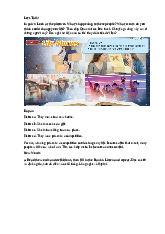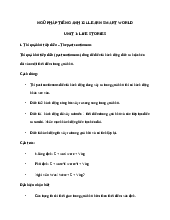






Preview text:
Let's Talk!
In pairs: Look at the pictures. How do you think these people feel? Which life events do you think they’re experiencing? What situations or events would make you feel the same? Theo cặp: Quan sát các bức tranh. Bạn nghĩ những người này cảm thấy thế nào? Bạn nghĩ họ đang trải qua những sự kiện nào trong cuộc sống? Những tình huống hoặc sự kiện nào sẽ khiến bạn cảm thấy như vậy?

Đáp án
I think these people feel happy.
Picture a: the girl has a new electric bike.
Picture b: they have a baby.
For me, passing an important exam like an entrance exam brings me the same feeling.
New Words
a. Read the idioms and definitions, then fill in the blanks with the correct idioms. Use the correct verb form and possessive adjectives. Listen and repeat. Đọc các thành ngữ và định nghĩa, sau đó điền vào chỗ trống những thành ngữ đúng. Sử dụng đúng dạng động từ và tính từ sở hữu. Lắng nghe và lặp lại.

Đáp án
2 - was on cloud nine
3 -was/ got bent out of shape
4 - was beyond my wildest dreams
5 -was a blessing in disguise
6 - my life depended on it.
7 - had/ got butterflies in my stomach
8 - the end of the world
b. Which of the idioms below do you know? What do they mean? Bạn biết thành ngữ nào dưới đây? Có ý nghĩa gì?
look/feel like a million bucks, cost an arm and a leg, a piece of cake, go round in circles, a fish out of water
Đáp án
- look/feel like a million bucks: nhìn, cảm thấy rất đẹp
- cost an arm and a leg: tốn/trả nhiều tiền
- a piece of cake: một việc rất dễ làm
- go round in circles: làm việc chăm chỉ ở cái gì đó hoặc thảo luận về cái gì đó mà không đạt được tiến bộ nào
- a fish out of water: một người cảm thấy không thoải mái vì họ đang ở trong một môi trường xa lạ
c. Use the new idioms to talk about how you felt during different experiences. Sử dụng các thành ngữ mới để nói về cảm giác của bạn trong những trải nghiệm khác nhau.
I was on cloud nine when I got my cat.
Listening
a. You will hear a girl talking about a presentation she did. What feelings do you think the girl will mention? Circle three. Bạn sẽ nghe một cô gái nói về bài thuyết trình mà cô ấy đã thực hiện. Bạn nghĩ cô gái sẽ đề cập đến cảm xúc gì? Hãy khoanh ba cái.
b. Now, listen and put the feelings she mentions in the order you hear. Write a number on the line. How many feelings did you guess correctly? Bây giờ, hãy lắng nghe và sắp xếp những cảm xúc mà cô ấy đề cập đến theo thứ tự bạn nghe được. Viết một số trên dòng. Bạn đã đoán đúng bao nhiêu cảm xúc?
c. Listen again and fill in the blanks with no more than four words. Nghe lại và điền vào chỗ trống không quá bốn từ.

d. Read the Conversation Skill box, then listen and repeat. Đọc hộp Kỹ năng hội thoại, sau đó nghe và lặp lại.
Conversation Skill
Introducing a story
To introduce a story, say:
Hey, you're not going to believe this, but…
Hey, did I ever tell you about….?
e. Now, listen to the conversation again and circle the phrase that you hear. Bây giờ, hãy nghe lại đoạn hội thoại và khoanh tròn cụm từ mà bạn nghe được.
f. In pairs: What would make you experience the feelings Alice had? Why? Theo cặp: Điều gì khiến bạn trải qua những cảm xúc mà Alice đã có?
Grammar
a. Read about adverbial clauses of manner (like, as if, as though), then fill in the blank. Đọc về các mệnh đề trạng từ chỉ cách thức, sau đó điền vào chỗ trống.

Đáp án
A: How did you do?
B: I studied as if my life depended on it, and I passed!
b. Listen and check. Listen again and repeat. Nghe và kiểm tra. Nghe lại và lặp lại.
c. Tick the correct sentences. Đánh dấu vào câu đúng.

Đáp án
Câu đúng: 1 ; 2 ; 4 ; 7 ; 8
d. Rewrite the sentences by replacing the adjectives or adverbs with the prompts. Viết lại câu bằng cách thay thế tính từ hoặc trạng từ bằng từ gợi ý.

Đáp án
1 -She looked as though she got butterflies in her stomach.
2 - I felt like the fastest student at my school.
3 - He studied as if his life depended on it.
4 - They act as though they are experts.
5 - He looks as if he saw a ghost.
e. In pairs: Imagine that the things below happened to you. Say how you felt and what you did. Theo cặp: Hãy tưởng tượng những điều dưới đây đã xảy ra với bạn. Nói bạn cảm thấy thế nào và bạn đã làm gì.

I felt as if moving to a new city was a blessing in disguise. I was sad to leave my hometown, but I made lots of new friends.
Pronunciation
a. /d/ sounds at the end of words often sound like /b/ when the next word begins with /m/ or /b/ ‘... had my ..' often sounds like /hæb mai/. Âm /d/ ở cuối từ thường phát âm giống /b/ khi từ tiếp theo bắt đầu bằng /m/ hoặc /b/'... had my ..' thường nghe giống như /hæb mai/.
b. Listen. Notice the sound changes of the underlined letters. Nghe. Chú ý sự thay đổi âm thanh của các chữ cái được gạch chân.
It was beyond my wildest dreams.
I had butterflies in my stomach.
c. Listen and cross out the sentence that doesn't follow the note in Task a. Nghe và gạch bỏ câu không theo ghi chú ở bài tập a.
It made me really happy.
I had bad dreams about it.
d. Practice reading the sentences with the sound changes noted in Task a to a partner. Luyện đọc các câu có sự thay đổi âm thanh được ghi chú trong Bài tập a cho bạn cùng lớp.
Practice
a. Listen, then take turns asking and answering using the pictures and prompts. Nghe, sau đó lần lượt hỏi và trả lời bằng hình ảnh và gợi ý.
A: Hey, have I ever told you about the time I traveled alone?
B: No. What happened?
A: I went to India for two weeks.
B: How did you feel?
A: I felt as if I was a fish out of water.

Đáp án
A: Hey, have I ever told you about the time I won a chess competition?
B: No. What happened?
A: I beat the school champion.
B: How did you feel?
A: I felt as if it was beyond my wildest dreams.
***
A: Hey, have I ever told you about the time I took swimming lessons?
B: No. What happened?
A: I swam as though my life depended on it.
B: How did you feel?
A: I felt as if I was on cloud nine after.
b. Practice with your own ideas. Thực hành với ý tưởng của riêng em.
Speaking
a. In pairs: Look at the list below and think of three more situations in which you would feel strong emotions. Theo cặp: Nhìn vào danh sách dưới đây và nghĩ về ba tình huống nữa mà bạn sẽ cảm thấy cảm xúc mạnh mẽ.

Đáp án
4. argued with my parents
5. didn’t prepare for an exam
6. move to a new school
b. Student A, choose one of the situations that happened to you and tell Student B about it. Use idioms to make your story more interesting. Student B, ask the questions below or your own ideas. Swap roles and repeat. Học sinh A, hãy chọn một trong những tình huống đã xảy ra với bạn và kể cho Học sinh B nghe về điều đó. Sử dụng thành ngữ để làm cho câu chuyện của bạn thú vị hơn. Học sinh B, hãy đặt những câu hỏi dưới đây hoặc theo ý kiến riêng của bạn. Đổi vai và lặp lại.
- What happened?
- What did you do?
- How did you feel?
- What was it like?
c. Join a new partner. Student A, tell your story again. Student B, listen and ask the questions above or your own ideas. Swap roles and repeat. Tham gia một bạn mới. Học sinh A, kể lại câu chuyện của bạn. Học sinh B nghe và đặt các câu hỏi trên hoặc theo ý kiến của mình. Đổi vai và lặp lại.
Trên đây là Giải Tiếng Anh lớp 12 Unit 1 lesson 2 i Learn Smart World trang 8 - 11.



